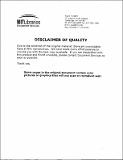| dc.contributor.advisor | Rudolph Jaenisch. | en_US |
| dc.contributor.author | Humpherys, David G. (David Glenn), 1972- | en_US |
| dc.contributor.other | Massachusetts Institute of Technology. Dept. of Biology. | en_US |
| dc.date.accessioned | 2005-08-23T19:44:12Z | |
| dc.date.available | 2005-08-23T19:44:12Z | |
| dc.date.copyright | 2002 | en_US |
| dc.date.issued | 2002 | en_US |
| dc.identifier.uri | http://hdl.handle.net/1721.1/8384 | |
| dc.description | Thesis (Ph.D.)--Massachusetts Institute of Technology, Dept. of Biology, 2002. | en_US |
| dc.description | Includes bibliographical references. | en_US |
| dc.description.abstract | Most cloned mammals derived by nuclear transfer (NT) die during gestation, and those surviving to birth frequently show increased birth weights, enlarged dysfunctional placentas, and neonatal mortality associated with respiratory distress and metabolic abnormalities. These abnormalities may reflect inadequate reprogramming of the donor nucleus to a state fully compatible with normal development. As inadequate reprogramming should lead to abnormal gene regulation in the clones, we have examined gene expression in clones to determine the extent of dysregulation and whether particular genes are commonly affected in clones. Abnormal imprinted gene expression has been proposed as a likely cause for some phenotypes observed in clones. Imprinted genes frequently affect fetal growth and some phenotypes similar to those seen in cloning are found upon in vitro embryo culturing, a process known to affect the expression of some imprinted genes. Because imprinting is normally established in the gametes and maintained in the early embryo, imprinted genes are likely to be resistant to reprogramming after nuclear transfer. We have examined imprinted gene expression in neonatal cloned mice derived from embryonic stem (ES) cells. In ES cell NT mice and their placentas, we found that many imprinted genes had abnormal gene expression levels. Similar expression abnormalities were observed upon in vitro differentiation of the ES cell donor populations from which the NT mice were derived. Additionally, mice cloned from the same ES cell subclone showed significantly varying imprinted gene expression suggesting that the epigenetic state of the ES cell genome was unstable. | en_US |
| dc.description.abstract | (cont.) However, the abnormal expression of any given imprinted gene did not correlate with abnormal expression at any other loci or with the various cloning phenotypes. Thus, imprinted gene expression appeared stochastically affected in the clones and some abnormalities in gene expression could be traced to the donor ES cell populations. To determine whether abnormal gene expression extended beyond the examined imprinted genes, we assessed global gene expression by microarray analysis on RNA from the placentas and livers of neonatal cloned mice. This analysis allowed us to determine whether differences in gene expression existed between different types of donor cells. Direct comparison of gene expression profiles of over 10,000 genes in ES cell and cumulus cells NT mice showed that in clones derived from both donor cell types approximately 4% of the expressed genes in the placentas differed dramatically from those in controls and that the majority of abnormally expressed genes were common to both types of clones. Importantly, however, the expression of a smaller subset of genes differed between the ES cell and cumulus cell derived clones. The livers of the cloned mice also showed abnormal gene expression although to a lesser extent, and with a different set of affected genes, than seen in the placentas. Our results demonstrate frequent abnormal gene expression in clones, in which many expression abnormalities appear common to the nuclear transfer procedure while others appear to reflect the particular donor nucleus. Surprisingly, many clones survived neonatally despite widespread gene dysregulation, indicating that mammalian development can tolerate many epigenetic abnormalities. | en_US |
| dc.description.statementofresponsibility | by David G. Humphreys. | en_US |
| dc.format.extent | 103 leaves | en_US |
| dc.format.extent | 8095868 bytes | |
| dc.format.extent | 8095628 bytes | |
| dc.format.mimetype | application/pdf | |
| dc.format.mimetype | application/pdf | |
| dc.language.iso | eng | en_US |
| dc.publisher | Massachusetts Institute of Technology | en_US |
| dc.rights | M.I.T. theses are protected by copyright. They may be viewed from this source for any purpose, but reproduction or distribution in any format is prohibited without written permission. See provided URL for inquiries about permission. | en_US |
| dc.rights.uri | http://dspace.mit.edu/handle/1721.1/7582 | |
| dc.subject | Biology. | en_US |
| dc.title | Gene expression and imprinting in mice cloned by nuclear transfer | en_US |
| dc.type | Thesis | en_US |
| dc.description.degree | Ph.D. | en_US |
| dc.contributor.department | Massachusetts Institute of Technology. Department of Biology | |
| dc.identifier.oclc | 50574044 | en_US |
